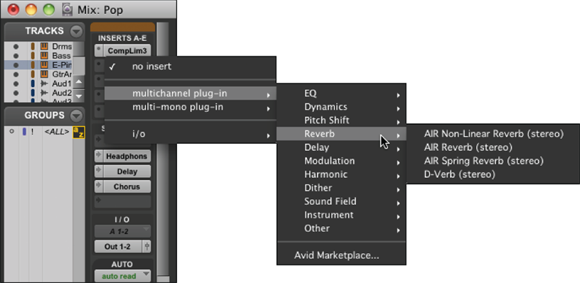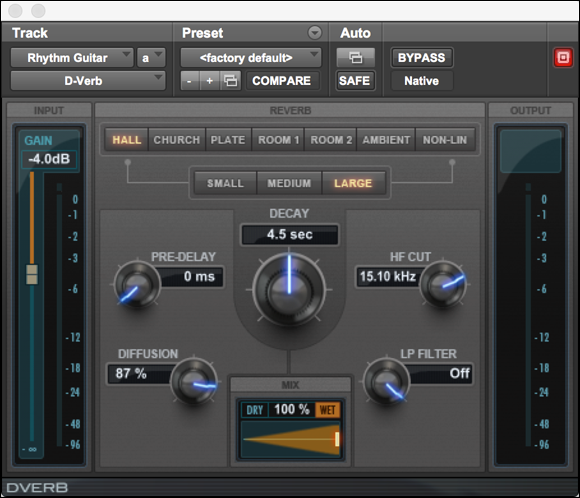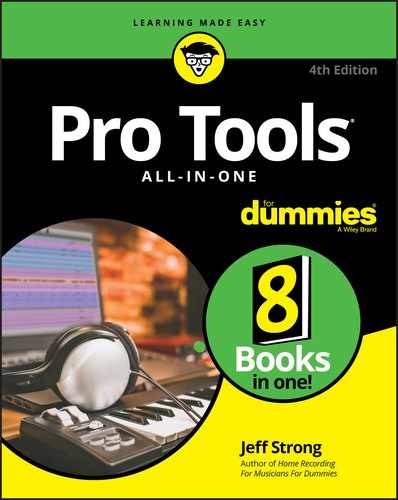Chapter 5
Singling Out Signal Processors
IN THIS CHAPTER
![]() Understanding and using effects in Pro Tools
Understanding and using effects in Pro Tools
![]() Getting to know reverb
Getting to know reverb
![]() Introducing delays
Introducing delays
![]() Examining offline effects processing
Examining offline effects processing
Unless you record your songs using a live band in a perfect acoustic environment, your music will sound a little flat without the addition of some type of effects. Effects allow you to make your music sound like you recorded it in just about any environment possible. You can make your drums sound as if they were recorded in a cathedral or your vocals sound as if you were singing underwater. Effects can also make you sound “better” than the real you. For example, you can add harmony parts to your lead or backup vocals, or you can make your guitar sound like you played it through any number of great amplifiers.
In this chapter, you discover many of the most common effects processors used in recording studios. (Signal processors are the neat software plug-ins behind all the effects you can achieve in your Pro Tools studio.) You discern the difference between insert (that is, line) effects and send/return effects. You also get a chance to explore ways of using these processors, with recommendations for using reverb, delay, and chorus. To top it off, you get a glimpse into offline effects processing such as pitch-shifting.
Routing Your Effects
Effects processors can be used as either send/return or insert effects. In both cases, you can work with the dry (unaffected) signal and the wet (affected) signals separately. If you use the effect in a send/return routing, you can adjust the wet and dry signals with two track faders: Aux Send (opened by clicking the effect’s name in the Send list) and Auxiliary. If you use the effect in a line configuration, the plug-in window displays a Mix parameter where you can adjust the wet/dry balance.
You choose whether to insert an effect in a track or to use the Send function based upon what you intend to do. For example, if you insert the effect into a track (as described in the next section), that effect only alters the signal that exists on the track it’s inserted into. On the other hand, using an effect send for your effect allows you to route more than one track through that effect. (You can adjust the individual levels going to the send at each track so you still have control over how much effect is applied to each track going to the send.)
Further, inserting an effect always puts the effect before the fader in the track (pre-fader); if you use a send, you can choose whether the effect does its magic before (pre-fader) or after (post-fader) signal enters the fader that controls the track’s output. If you use a send to apply the effect to more than one track at a time, you also reduce the amount of processing power the effect has to use. (Inserting the same effect into each track you want to alter ends up using more processing power.)
Inserting effects
If you want to use an effect on only one specific track, you can insert it into the track by using the Insert function. To insert an effect in Pro Tools, follow these steps:
- Make sure that the Inserts section is showing in the Mix window by choosing View ⇒ Mix Window ⇒ Inserts from the main menu.
Click the top arrow on the left side of the Inserts section of the track’s channel strip.
The Insert drop-down menu appears, as shown in Figure 5-1.
If your track is a stereo track, select either the Multi-Channel Plug-In or Multi-Mono Plug-In option.
If your track is mono, you can choose mono or mono/stereo.
Choose your desired plug-in — D-Verb, Mod Delay III (mono), Mod Delay III (mono/stereo), whatever — from the menu.
The plug-in window opens. Here you can set your parameters. (My professional advice on what settings to actually tweak comes later in this chapter, when I cover the individual effects.)

FIGURE 5-1: The Insert menu opens when you click the Insert input selector.
Sending signals to effects
Sometimes you want to route a bunch of tracks to a single effect (in the case of reverbs, for instance). In this case, you follow these steps:
Select one of the buses from the Send selector in each track that you want to route to the effect.
The Send Output window appears, as shown in Figure 5-2. The window contains a handy channel strip for controlling the signal being sent to the selected bus.
Choose Track ⇒ New from the main menu.
The New Tracks dialog box appears.
- Use the drop-down menus to enter the number of tracks you want (1), the type (Auxiliary Input), and whether you want your track in mono or stereo.
- From the Input selector drop-down menu, choose the bus you used for the send of the tracks in Step 1 as the input for this auxiliary track.
Choose one of the effects plug-ins from the Inserts drop-down menu and insert it into this auxiliary track.
The Effect plug-in window opens.
 The previous section, “Inserting effects,” gives you the gory details on inserting effects.
The previous section, “Inserting effects,” gives you the gory details on inserting effects.- Adjust the effect settings to get the sound you want.

FIGURE 5-2: Use the Send Output window to control the signal going to the effect.
Rolling Out the Reverb
Reverb is undoubtedly the most commonly used effects processor. Reverb, the natural characteristic of any enclosed room, results from sound waves bouncing off walls, a floor, and a ceiling. A small room produces reflections that start quickly and end soon; in larger rooms, halls, or cathedrals, the sound has farther to travel, so you get slower start times and a longer-lasting reverberation.
This room effect enables you to place your track closer to the imaginary “front” or “back” of the mix. You do this by varying how much of the affected signal you include with the unaffected one. For example, mixing a lot of reverb with the dry (unaffected) signal gives the impression of being farther away, so your instrument sounds like it’s farther back in the mix.
Seeing reverb settings
You can adjust several parameters when you use reverb, which gives you a lot of flexibility. Figure 5-3, which shows the Reverb plug-in that comes with Pro Tools, gives you a peek at the parameters you can play with.

FIGURE 5-3: Reverb can add ambience to your instrument, giving it a more realistic sound.
The following list explains how the parameters — most, but not all, visible in Figure 5-3 — affect the sound of the reverb:
- Algorithm: This setting lets you choose the type of room that the reverb sounds like. You have the option of a hall, church, plate (a type of reverb that uses a metal plate to create its sound), two different rooms, ambient (natural room sound), and nonlinear (less natural) sound. Each choice also sets the other parameters for the reverb, but you can adjust those as you like to give your reverb a distinct sound.
- Size: This option refers to the “room” choices you have in the Algorithm setting. You have three settings to choose from: Small, Medium, and Large. Clicking one of these options adjusts the rest of the parameters in the window, except for the Algorithm setting.
- Diffusion: Diffusion affects the density of the reflections in the “room” you chose. A higher diffusion setting results in a thicker sound. Think of the diffusion parameter as a way to simulate how reflective the room is. More reflective rooms produce a much higher diffusion. To simulate a less reflective room, use lower-diffusion settings.
- Decay:Decay is the length of time that the reverb lasts. Larger or more reflective rooms produce a longer decay.
Pre-delay: A sound reaches your ears before the sound’s reverb does, and predelay is the amount of time from the sound’s beginning and the start of the reverb, which is described in milliseconds (ms). Because reverb is made up of reflections of sound within a room, the sound takes time to bounce around the room and reach your ears. By then, you’ve already heard the sound because it came directly to you. Predelay helps to define the initial sound signal by separating it from the reverb. This parameter is essential in making your reverb sound natural.
 A small room has a shorter predelay than a large room.
A small room has a shorter predelay than a large room.- HF Cut: This setting allows you to control the rate at which the high frequencies decay. Most of the time the high frequencies decay faster, so being able to control this effect can result in a more natural sounding reverb.
- LP Filter: This filter controls the level of the high frequencies within the reverb. Setting this frequency gives the impression of a darker (lower-frequency setting) or brighter (higher-frequency setting) room.
Getting started using reverb
Reverb is like garlic: The more you use, the less you can taste it. Just as a new chef puts garlic in everything (and lots of it), many budding engineers make the same mistake with reverb. Go easy. Always remember that less is more.
Here are some other things to keep in mind:
- Mixes often sound better when you use reverb on only a few instruments instead of them all. For example, it’s not uncommon for just the snare drum of the drum set to have reverb on it. The rest of the drums and cymbals remain dry (unaffected).
- Try using reverb to “glue” instruments together. Routing all your drum tracks to the same reverb, for instance, can make them sound like they were all recorded in the same room. When doing this, make sure that you adjust the Send level for each instrument so that the effect sounds natural. Also, use less reverb for all the instruments than you would for just one. This keeps the sound from becoming muddy from using too much reverb.
- Think about how you want each instrument to sit in the mix when you choose reverb. Make sure that the type and amount of reverb fits the song and the rest of the instruments.
- Try putting the dry (unaffected) sound on one side of the stereo field and the reverb on the other. For example, if you have a rhythm guitar part that you set at 30 degrees off to the right of the stereo field, set the reverb 30 degrees off to the left. This can be a nice effect.
- To keep the vocals up front in the mix, use a short reverb setting. A vocal plate is a great choice because the decay is fast. This adds a fair amount of the reverb to the vocal without making it sit way back in the mix.
- Experiment with room types, sizes, and decay times. Sometimes, a long decay on a small room reverb sounds better than a short decay on a large room or hall reverb.
Detailing Delay
Along with reverb, delay is a natural part of sound bouncing around a room. When you speak (or sing or play) into a room, you often hear not only reverb but also a distinct echo. This echo may be short or long, depending on the size of the room. The original sound may bounce back to you as a single echo or as multiple, progressively quieter delays.
Digging into delay settings
At your disposal are several types of delay effects, including a slap-back echo, tape delay, and multiple delays. Each is designed to add dimension to your instrument. To create these various effects, you adjust several parameters, as the following list and Figure 5-4 make clear. The Delay plug-ins that come with Pro Tools are pretty much the same. (Okay, the default setting for each is different, but that’s a pretty minor thing.) The parameters that you can adjust include the following:
- Input: This shows you the level of the signal entering the delay.
- Delay: This parameter controls the amount of time between the initial signal and the repeated sound. The time is listed in milliseconds and can be as short as a few milliseconds or as long as several seconds. This section lets you adjust the following settings:
- FBK (Feedback): The Feedback parameter controls how many times the echo repeats. A low setting makes the echo happen just once, and higher settings produce more echoes.
- LPF: The Low Pass filter (LPF) lets you filter some of the high frequencies from the delay.
- Sync: This button synchronizes the delay to the metronomic beat of your session.
- Meter: This option lets you set the meter of the song and the subdivision that you want the delay to follow. When you change this parameter, the Delay parameter moves, too.
- Tempo: This option allows you to set the delay to beat in time with the music. The Tempo Match feature is referenced to the tempo map that you set for the song. You can set this parameter to any note division, from sixteenth notes to whole notes, if you want the delays to keep time with your song. (Quarter- and eighth-note delays are the most commonly used note divisions.)
- Groove: Use this parameter to adjust the rate of the delay in relation to the tempo and subdivision you chose. By changing this setting, you alter the delay (by percentages) away from the strict tempo and subdivision settings. This can be useful if you’re adjusting the exact delay that you want. When you adjust this parameter, the Delay setting changes as well.
- Modulation: This section adds a chorus effect to the delay. You have two parameters you can tweak:
- Rate: This setting lets you set the amount of time that the modulation takes to cycle.
- Depth: This parameter controls the overall degree of the modulation. (See the “Creating Chorus Effects” section, later in this chapter, for more on chorus and flange effects.) The higher the level on this setting, the greater the modulation.
- Gain: This lets you set the signal level going into the delay.
- Mix: This parameter controls the output level of the effect. The higher you set this parameter, the louder the delayed signal is relative to the original signal.

FIGURE 5-4: A Delay plug-in allows you to create various echoes.
Getting started using delay
Delay is used a lot in contemporary music, and often you don’t hear it unless you listen carefully. Other times, it’s prominent in the mix (for example, the snare drum in some reggae music). Here are ways you can use delay in your music:
- One of the most effective ways to use delay is as a slap-back echo on vocals. A slap-back echo consists of one to three repeats spaced very closely together, which fattens the sound of the vocals. You generally want to set your time parameter between 90 and 120 ms. Set the level so you barely hear the first echo when your vocal is in the mix and adjust it from there until you like the sound. In pop music, a slap-back echo and a vocal plate reverb are commonly used on lead vocals. (It was really common in the 1950s, and shows up a lot — less subtly — in rockabilly.) The Slap Delay plug-in in Pro Tools is a good place to start, although the default setting has a longer delay time than I recommend.
- Use the Tempo Match feature to have your delay echo in time with the music. This can add some depth to the mix without creating a muddy or cluttered sound. Be careful because if you use this too much, it can make your music sound annoyingly repetitive.
Creating Chorus Effects
Chorus takes the original sound and creates a copy that is very slightly out of tune with the original and varies over time. This variance is modulation, and the result is an effect that can add interest and variety to an instrument. Chorus is used quite extensively to add fullness to an instrument, particularly guitars and vocals. Pro Tools doesn’t come with a Chorus plug-in per se, but all Delay plug-ins can produce chorusing effects by adjusting the Depth and Rate parameters. (Check out the “Detailing Delay” section, earlier in this chapter, for more on delays.)
If reverb is like garlic, then chorus is like cayenne pepper. You may get away with a little too much garlic in your food without too much trouble, but if you add too much cayenne, you run the risk of making your food inedible. Such is the case with the chorus effect. Used sparingly, it can add a lot to your music; overdone, it can wreak havoc on a good song.
- To fill out a vocal track, try setting the rate at 2 Hz, the depth at about 20 to 30, and the delay at 10 to 20 ms. Keep the Feedback level low.
- Use a chorus on backup vocals to make them much fuller and allow you to use fewer tracks.
- Pan the chorus to one side of the mix and the dry (unaffected) signal to the other. This can be especially interesting on guitars and synthesizer patches.
